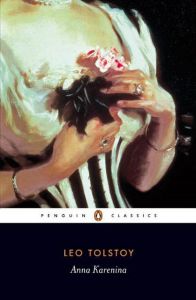Leo Tolstoy, Anna Karenina, 1878

Nineteenth-century fiction creates the illusion of a fully realised social world – one that shapes the psychological development of its main characters. In many novels from this period, individual desires clash with dynastic imperatives, social conservatism, the careful negotiations of marriage and family life, and the traditional distribution of wealth.
Leo Tolstoy’s Anna Karenina (serialised between 1875 and 1877, then published in book form in 1878) is a pre-eminent example of this kind of fiction. It often features on lists of the greatest novels ever written, not least for its moving dramas of the self and its vividly realised scenes of urban and rural life.
In structural terms, Anna Karenina features several overlapping narrative arcs: a passionate love story, a family saga, and a conversion narrative. These plots are set against Tolstoy’s powerful evocation of pre-revolutionary Russian society and its uneasy social, cultural, religious, and economic politics. The action moves between Moscow, Saint Petersburg, and the feudal estates of Konstantin Levin in the Russian countryside, while the novel’s emotional energies are concentrated around two quite different characters: the unhappily married Anna Karenina in her search for happiness, and Levin himself, in his search for meaning in his life, work, and community.
This masterclass will focus on the narrative arcs of Anna and Levin, and the different dimensions of the emotional and social fabric of the novel. We will also make a special study of the way Tolstoy uses facial expressions to draw attention to moments of greater intensity and emotional interaction between characters. How do these forms of facial rhetoric — and their capacity to invoke visual images — contribute to the experience of reading this immersive novel?

Professor Stephanie Trigg
Stephanie Trigg FAHA is Redmond Barry Distinguished Professor of English Literature at the University of Melbourne, and the current President of the New Chaucer Society (2022–2024). Most of her teaching and research is in the areas of the history of emotions, medieval literature, and medievalism. Her chief publications include Congenial Souls: Reading Chaucer from Medieval to Postmodern (2002) and Shame and Honor: A Vulgar History of the Order of the Garter (2012); and with Thomas A. Prendergast, Affective Medievalism: Love, Abjection and Discontent (2019) and 30 Great Myths about Chaucer (2020).
Her current research is focussed around an Australian Research Council Discovery Project, with Joe Hughes and Tyne Sumner at the University of Melbourne, and Guillemette Bolens at the University of Geneva: ‘Literature and the Face: A Critical History’. This project stretches from medieval to contemporary literature, examining the representations of the human face and faciality from medieval poetry and the pre-history of the novel into contemporary fiction and lyric poetry. It pays special attention to the face as a turning-point in narrative structures, the rhetoric of facial expression, the relation between visual and textual imagery, facial and perceptual difference, and questions of surveillance.